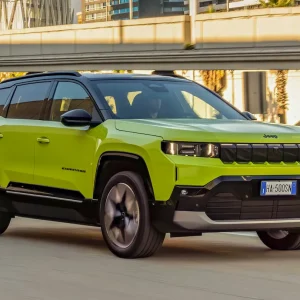As mid-life upgrades go, the Edge facelift seems subtle at first glance. But look beyond the smarter headlamps and bolder grille, and you’ll find plenty has changed
Ford’s largest SUV in Europe has always been a bit low-key in the UK, selling around 8,000 units since it went on sale in 2016.
Larger and more upmarket than the Kuga, the first Edge models to reach Europe were actually in the car’s third generation, having originally been conceived with North American customers in mind.

With expectations set at a moderate level, it was a pleasant surprise to find that the third-generation Edge was good to drive, comfortable and looked good too.
Perhaps the biggest disappointment – and a result of its rakish styling – was unlike the Kia Sorento and Hyundai Santa Fe, there was no seven-seat version.
In North America, Ford sells much larger SUVs than the Edge with plenty more seats. That particular aspect aside, changes for 2019 should make it more appealing.
New engine choices
Previously, customers could choose from 180hp or 210hp versions of a 2.0-litre diesel, with a six-speed automatic available on the top versions. Now, the main engine variant for UK customers will be a bi-turbo 2.0-litre Ecoblue diesel with 238hp and an eight-speed automatic transmission.
Of course, under the new WLTP regime, CO2 emissions are higher than before – despite efforts to maintain fuel efficiency – at 180g/km for the ST-Line and Vignale versions.
But Ford is also offering a 150hp diesel version of the Edge for the first time, with front-wheel drive and an eight-speed automatic transmission.
CO2 emissions of 153g/km are fairly close to the figures of the old 180hp diesel, also bearing in mind the new car’s CO2 emissions are NEDC-correlated figures, with the older model using out-of-date NEDC.

And the all-wheel drive system also features an intelligent disconnect, reverting to two-wheel drive when the additional traction isn’t needed, and saving a little fuel.
Visual updates across the range include a wider grille with a unique finish for each model. Standard LED lights front and rear can be complemented with optional LED signature daytime running lamps. A redesigned bonnet attempts to give the Edge a wider, more planted stance.
The Titanium variant has 19in alloy wheels, chrome roof rails and a rear roof spoiler, alongside illuminated door-sill plates for the interior. The ST-Line exterior features body-coloured lower door, wing and side mouldings, standard 20in wheels or optional 21in high gloss black alloy wheels.
Inside, there are perforated part-leather seats, a perforated leather steering wheel, and gear shifter with red stitching for manual models, while sports-tuned suspension makes the Edge ST-Line feel a little sharper than the other models.
The new Edge Vignale has bespoke chrome-finish fog lamp surrounds, a signature hexagonal upper grille design with a dark matte finish and polished aluminium surround, and 20in polished alloy wheels.
Inside, hexagonal-quilted leather features on the seats, doors and leather extends to the central armrest, storage console and instrument panel.
New safety features
Safety is enhanced with the availability of what Ford calls Co-Pilot360 technology. Adaptive cruise control (ACC) with Stop & Go and Lane Centering helps the vehicle maintain a comfortable driving distance from vehicles ahead and alongside.

Stop & Go enables the ACC system to bring the vehicle to a complete halt in stop-start traffic using up to 50% of total braking force, and automatically pull away if the stopping duration is less than three seconds.
New Evasive Steering Assist uses radar and a camera to detect slower-moving and stationary vehicles ahead and provides steering support to enable drivers to manoeuvre around a vehicle if a collision is imminent.
The Edge also retains features of the earlier models, including blindspot alert, traffic sign recognition, glare-free main beam, and parking assistance.
The power boost from the upgraded engine is noticeable, but delivery is always smooth and refined. We drove the Edge in northern Sweden in November, with challenging wintry conditions (and studded winter tyres for maximum security and control on ice), and it was a chance to showcase the effectiveness and responsiveness of the four-wheel drive technology.
There may be five-seat SUVs with posher badges (the Range Rover Velar, for example), but that doesn’t make the Edge any less accomplished at what it does, and with an upmarket feel and high-end equipment grades, it could still have appeal for company directors more used to premium-badge 4x4s.
Ford Edge 2.0 Ecoblue ST-Line
P11D £41,700
On sale Now
Residual value 38%
Depreciation £25,800
Fuel £8,964
Service, maintenance and repair £2,874
Cost per mile 62.73p
Fuel consumption 40.9mpg
CO2 (BIK band) 180g/km (37%)
BIK 20/40% a month £257/£514
Boot space 602 litres
Engine size/power 1,997cc/238hp





